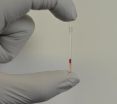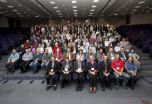(Press-News.org) CAMBRIDGE, Mass-- Conventional wisdom has long held that corals — whose calcium-carbonate skeletons form the foundation of coral reefs — are passive organisms that rely entirely on ocean currents to deliver dissolved substances, such as nutrients and oxygen. But now scientists at MIT and the Weizmann Institute of Science (WIS) in Israel have found that they are far from passive, engineering their environment to sweep water into turbulent patterns that greatly enhance their ability to exchange nutrients and dissolved gases with their environment.
"These microenvironmental processes are not only important, but also unexpected," says Roman Stocker, an associate professor of civil and environmental engineering at MIT and senior author of a paper describing the results in the Proceedings of the National Academy of Sciences.
When the team set up their experiment with living coral in tanks in the lab, "I was expecting that this would be a smooth microworld, there would be not much action except the external flow," Stocker says. Instead, what the researchers found, by zooming in on the coral surface with powerful microscopes and high-speed video cameras, was the opposite: Within the millimeter closest to the coral surface, "it's very violent," he says.
It's long been known that corals have cilia, small threadlike appendages that can push water along the coral surface. However, these currents were previously assumed to move parallel to the coral surface, in a conveyor-belt fashion. Such smooth motion may help corals remove sediments, but would have little effect on the exchange of dissolved nutrients. Now Stocker and his colleagues show that the cilia on the coral's surface are arranged in such a way as to produce strong swirls of water that draw nutrients toward the coral, while driving away potentially toxic waste products, such as excess oxygen.
Not just passive
"The general thinking has been that corals are completely dependent upon ambient flow, from tides and turbulence, to enable them to overcome diffusion limitation and facilitate the efficient supply of nutrients and the disposal of dissolved waste products," says Orr Shapiro, a postdoc from WIS and co-first author on the paper, who spent a year in Stocker's lab making these observations.
Under such a scenario, colonies in sheltered parts of a reef or at slack tide would see little water movement and might experience severe nutrient limitation or a buildup of toxic waste, to the point of jeopardizing their survival. "Even the shape of the coral can be problematic" under that passive scenario, says Vicente Fernandez, an MIT postdoc and co-first author of the paper. Coral structures are often "treelike, with a deeply branched structure that blocks a lot of the external flow, so the amount of new water going through to the center is very low."
The team's approach of looking at corals with video microscopy and advanced image analysis changed this paradigm. They showed that corals use their cilia to actively enhance the exchange of dissolved molecules, which allows them to maintain increased rates of photosynthesis and respiration even under near-zero ambient flow.
The researchers tested six different species of reef corals, demonstrating that all share the ability to induce complex turbulent flows around them. "While that doesn't yet prove that all reef corals do the same," Shapiro says, "it appears that most if not all have the cilia that create these flows. The retention of cilia through 400 million years of evolution suggests that reef corals derive a substantial evolutionary advantage" from these flows.
Corals need to stir it up
The reported findings transform the way we perceive the surface of reef corals; the existing view of a stagnant boundary layer has been replaced by one of a dynamic, actively stirred environment. This will be important not only to questions of mass transport, but also to the interactions of marine microorganisms with coral colonies, a subject that attracts much attention due to a global increase in coral disease and reef degradation over the past decades.
Besides illuminating how coral reefs function, which could help better predict their health in the face of climate change, this research could have implications in other fields, Stocker suggests: Cilia are ubiquitous in more complex organisms — such as inside human airways, where they help to sweep away contaminants.
But such processes are difficult to study because cilia are internal. "It's rare that you have a situation in which you see cilia on the outside of an animal," Stocker says — so corals could provide a general model for understanding ciliary processes related to mass transport and disease.
INFORMATION:
In addition to Stocker, Shapiro, and Fernandez, the research team included Assaf Vardi, faculty at WIS; postdoc Melissa Garren; former MIT postdoc Jeffrey Guasto, now an assistant professor at Tufts University; undergraduate François Debaillon-Vesque from MIT and the École Polytechnique in Paris; and Esti Kramarski-Winter from WIS. The work was supported by the Human Frontiers in Science Program, the National Science Foundation, the National Institutes of Health, and the Gordon and Betty Moore Foundation.
Written by David Chandler, MIT News Office
Nature's tiny engineers
Coral organisms use minuscule appendages to control their environment, stirring up water eddies to bring nutrients
2014-09-01
ELSE PRESS RELEASES FROM THIS DATE:
Location of body fat can increase hypertension risk
2014-09-01
WASHINGTON (Sept. 1, 2014) — People with fat around their abdominal area are at greater risk of developing hypertension when compared to those with similar body mass index but fat concentrations elsewhere on the body, according to a study published today in the Journal of the American College of Cardiology.
Obesity is a known risk factor for hypertension, or high blood pressure, and it is widely reported that the location of fat on a person's body can lead to increased risk of other health issues like heart disease and cancer. However, the relationship between hypertension ...
Ride-sharing could cut cabs' road time by 30 percent
2014-09-01
CAMBRIDGE, Mass-- Cellphone apps that find users car rides in real time are exploding in popularity: The car-service company Uber was recently valued at $18 billion, and even as it faces legal wrangles, a number of companies that provide similar services with licensed taxi cabs have sprung up.
What if the taxi-service app on your cellphone had a button on it that let you indicate that you were willing to share a ride with another passenger? How drastically could cab-sharing reduce traffic, fares, and carbon dioxide emissions?
Authoritatively answering that question ...
Faster, cheaper tests for sickle cell
2014-09-01
Within minutes after birth, every child in the U.S. undergoes a battery of tests designed to diagnose a host of conditions, including sickle cell disease. Thousands of children born in the developing world, however, aren't so lucky, meaning many suffer and die from the disease each year.
A.J. Kumar hopes to put a halt to at least some of those deaths.
A Post-Doctoral Fellow in Chemistry and Chemical Biology working in the lab of George Whitesides, the Woodford L. and Ann A. Flowers University Professor, Kumar and colleagues, including other co-authors, have developed ...
Training your brain to prefer healthy foods
2014-09-01
BOSTON (September 1, 2014, 10:20 AM EDT) — It may be possible to train the brain to prefer healthy low-calorie foods over unhealthy higher-calorie foods, according to new research by scientists at the Jean Mayer USDA Human Nutrition Research Center on Aging (USDA HNRCA) at Tufts University and at Massachusetts General Hospital. Published online today in the journal Nutrition & Diabetes, a brain scan study in adult men and women suggests that it is possible to reverse the addictive power of unhealthy food while also increasing preference for healthy foods.
"We don't start ...
Fruit consumption cuts CVD risk by up to 40 percent
2014-09-01
Barcelona, Spain – Monday 1 September 2014: Daily fruit consumption cuts the risk of cardiovascular disease (CVD) by up to 40%, according to research presented at ESC Congress today by Dr Huaidong Du from Oxford, UK. The findings from the seven year follow-up study of nearly 0.5 million people in the China Kadoorie Biobank found that the more fruit people ate, the more their risk of CVD declined.
Dr Du said: "CVD, including ischaemic heart disease (IHD) and stroke, is the leading cause of death worldwide. Improving diet and lifestyle is critical for CVD risk reduction ...
Permanent AF doubles risk of stroke compared to paroxysmal AF
2014-09-01
Barcelona, Spain – Monday 1 September 2014: Permanent atrial fibrillation (AF) doubles the risk of stroke compared to paroxysmal AF, according to research in more than 6 000 patients presented at ESC Congress today by Dr Thomas Vanassche from Belgium. The findings suggest that a simple clinical assessment of the type of AF can help doctors to better estimate stroke risk.
Ischaemic stroke is the second cause of death in the EU, accounting for over a million deaths and many more disabled patients each year. Annual direct health care costs amount to more than €20 billion. ...
A nucleotide change could initiate fragile X syndrome
2014-09-01
Researchers reveal how the alteration of a single nucleotide—the basic building block of DNA—could initiate fragile X syndrome, the most common inherited form of intellectual disability. The study appears in The Journal of Cell Biology.
Fragile X syndrome is caused by a defect in a gene on the X chromosome called fragile X mental retardation 1 (FMR1). Around 1 in 230 women and 1 in 360 men carry a so-called premutation, in which a series of DNA repeats at one end of the FMR1 gene is slightly longer than normal. These repeats are prone to even further expansion when ...
Scientists call for investigation of mysterious cloud-like collections in cells
2014-09-01
WASHINGTON — About 50 years ago, electron microscopy revealed the presence of tiny blob-like structures that form inside cells, move around and disappear. But scientists still don't know what they do — even though these shifting cloud-like collections of proteins are believed to be crucial to the life of a cell, and therefore could offer a new approach to disease treatment.
In the Journal of Cell Biology, two researchers are issuing a call to investigators from various backgrounds, from biophysics to cell biology, to focus their attention on the role of these formations— ...
Zooming in for a safe flight
2014-09-01
As nocturnal animals, bats are perfectly adapted to a life without light. They emit echolocation sounds and use the delay between the reflected echoes to measure distance to obstacles or prey. In their brains, they have a spatial map representing different echo delays. A study carried out by researchers at Technische Universität München (TUM) has shown for the first time that this map dynamically adapts to external factors.
Closer objects appear larger
When a bat flies in too close to an object, the number of activated neurons in its brain increases. As a result, ...
Week-long meeting on naming algae, fungi, and plants recorded for posterity
2014-09-01
The week-long discussions and decisions of the Nomenclature Section of the XVIII International Botanical Congress took place in Melbourne, Australia in July 2011. This meeting is held every six years and it is where the world's premier experts on the rules for naming algae, fungi and plants get together to debate and update the rule book for naming the organisms they study. This is the primary product of the meeting, the International Code of Nomenclature for algae, fungi, and plants, which was published in 2012. The other important product is the official report for the ...
LAST 30 PRESS RELEASES:
First Editorial of 2026: Resisting AI slop
Joint ground- and space-based observations reveal Saturn-mass rogue planet
Inheritable genetic variant offers protection against blood cancer risk and progression
Pigs settled Pacific islands alongside early human voyagers
A Coral reef’s daily pulse reshapes microbes in surrounding waters
EAST Tokamak experiments exceed plasma density limit, offering new approach to fusion ignition
Groundbreaking discovery reveals Africa’s oldest cremation pyre and complex ritual practices
First breathing ‘lung-on-chip’ developed using genetically identical cells
How people moved pigs across the Pacific
Interaction of climate change and human activity and its impact on plant diversity in Qinghai-Tibet plateau
From addressing uncertainty to national strategy: an interpretation of Professor Lim Siong Guan’s views
Clinical trials on AI language model use in digestive healthcare
Scientists improve robotic visual–inertial trajectory localization accuracy using cross-modal interaction and selection techniques
Correlation between cancer cachexia and immune-related adverse events in HCC
Human adipose tissue: a new source for functional organoids
Metro lines double as freight highways during off-peak hours, Beijing study shows
Biomedical functions and applications of nanomaterials in tumor diagnosis and treatment: perspectives from ophthalmic oncology
3D imaging unveils how passivation improves perovskite solar cell performance
Enriching framework Al sites in 8-membered rings of Cu-SSZ-39 zeolite to enhance low-temperature ammonia selective catalytic reduction performance
AI-powered RNA drug development: a new frontier in therapeutics
Decoupling the HOR enhancement on PtRu: Dynamically matching interfacial water to reaction coordinates
Sulfur isn’t poisonous when it synergistically acts with phosphine in olefins hydroformylation
URI researchers uncover molecular mechanisms behind speciation in corals
Chitin based carbon aerogel offers a cleaner way to store thermal energy
Tracing hidden sources of nitrate pollution in rapidly changing rural urban landscapes
Viruses on plastic pollution may quietly accelerate the spread of antibiotic resistance
Three UH Rainbow Babies & Children’s faculty elected to prestigious American Pediatric Society
Tunnel resilience models unveiled to aid post-earthquake recovery
Satellite communication systems: the future of 5G/6G connectivity
Space computing power networks: a new frontier for satellite technologies
[Press-News.org] Nature's tiny engineersCoral organisms use minuscule appendages to control their environment, stirring up water eddies to bring nutrients




